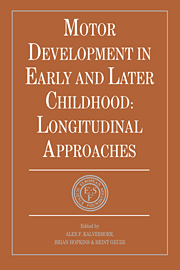Book contents
- Frontmatter
- Contents
- List of contributors
- Foreword
- Preface
- SETTING THE SCENE
- SECTION I BIOLOGICAL BASIS OF MOTOR DEVELOPMENT
- SECTION II DEVELOPMENT OF BODY POSTURE AND GOAL-DIRECTED REACHING
- SECTION III MOTOR DEVELOPMENT, EARLY COMMUNICATION AND COGNITION
- 9 Early interactional signalling: the role of facial movements
- 10 Motor development: communication and cognition
- 11 On faces and hands and the development of communication
- SECTION IV ACQUISITION OF SKILLS
- SECTION V MOTOR DEVELOPMENT AND HANDICAP
- SECTION VI METHODOLOGICAL AND CONCEPTUAL CONSIDERATIONS
- Epilogue: description versus explanation
- Index
9 - Early interactional signalling: the role of facial movements
from SECTION III - MOTOR DEVELOPMENT, EARLY COMMUNICATION AND COGNITION
Published online by Cambridge University Press: 05 May 2010
- Frontmatter
- Contents
- List of contributors
- Foreword
- Preface
- SETTING THE SCENE
- SECTION I BIOLOGICAL BASIS OF MOTOR DEVELOPMENT
- SECTION II DEVELOPMENT OF BODY POSTURE AND GOAL-DIRECTED REACHING
- SECTION III MOTOR DEVELOPMENT, EARLY COMMUNICATION AND COGNITION
- 9 Early interactional signalling: the role of facial movements
- 10 Motor development: communication and cognition
- 11 On faces and hands and the development of communication
- SECTION IV ACQUISITION OF SKILLS
- SECTION V MOTOR DEVELOPMENT AND HANDICAP
- SECTION VI METHODOLOGICAL AND CONCEPTUAL CONSIDERATIONS
- Epilogue: description versus explanation
- Index
Summary
INTRODUCTION
An attempt to draw attention to topics that are as complex and underresearched as interactional signalling and facial movements is rather problematic in the context of presentations stressing longitudinal research and the clinical assessment of movements. Neurological assessment of, and research on, normal and abnormal motor development have dealt mainly with simple motor patterns and tested them in simple stimulus-response situations. The significance of motor patterns as communicative signals has attracted relatively little attention in traditional neurology. Interactional processes have also been disregarded for a long time, probably due to methodological difficulties concerning standardization of interactional situations and statistical evaluation of dialogical phenomena in which differences between stimuli and responses disappear.
Only recently, developmental neurologists have come to the conclusion that more attention should be paid to qualitative assessments of complex movement patterns in the diagnoses of early neural dysfunctions (Prechtl, Chapter 3, this volume). Conversely, mothers seek medical assistance for young infants because of signs of disorder concerning complex patterns. The most frequent reasons are: (a) disturbances in autonomic functions, such as feeding and sleep; (b) communicative disorders, related to vocal and facial behaviours; (c) signs of inflammatory processes, such as pain, fever, rash, or paroxysms. Thus, to laymen, complex facial behaviours function rather frequently as indicators of neural dysfunctions.
It is interesting to consider facial movements from a psychobiological view with regard to their adaptive significance. Facial movements are intimately interrelated to communication, be it in the form of non-vocal facial gestures or movements involved in the production of vocal signals.
- Type
- Chapter
- Information
- Motor Development in Early and Later ChildhoodLongitudinal Approaches, pp. 136 - 152Publisher: Cambridge University PressPrint publication year: 1993
- 2
- Cited by



